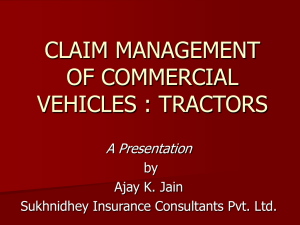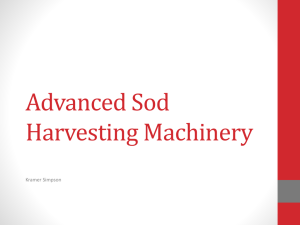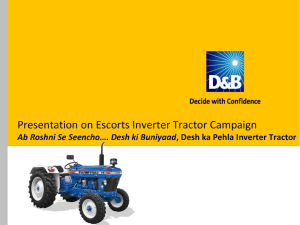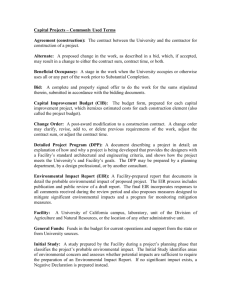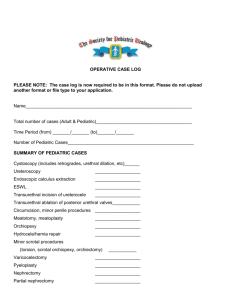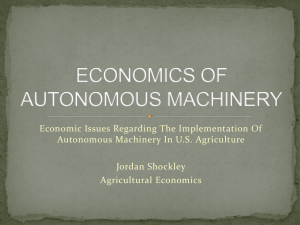Estimating Agricultural Field Machinery Costs
advertisement
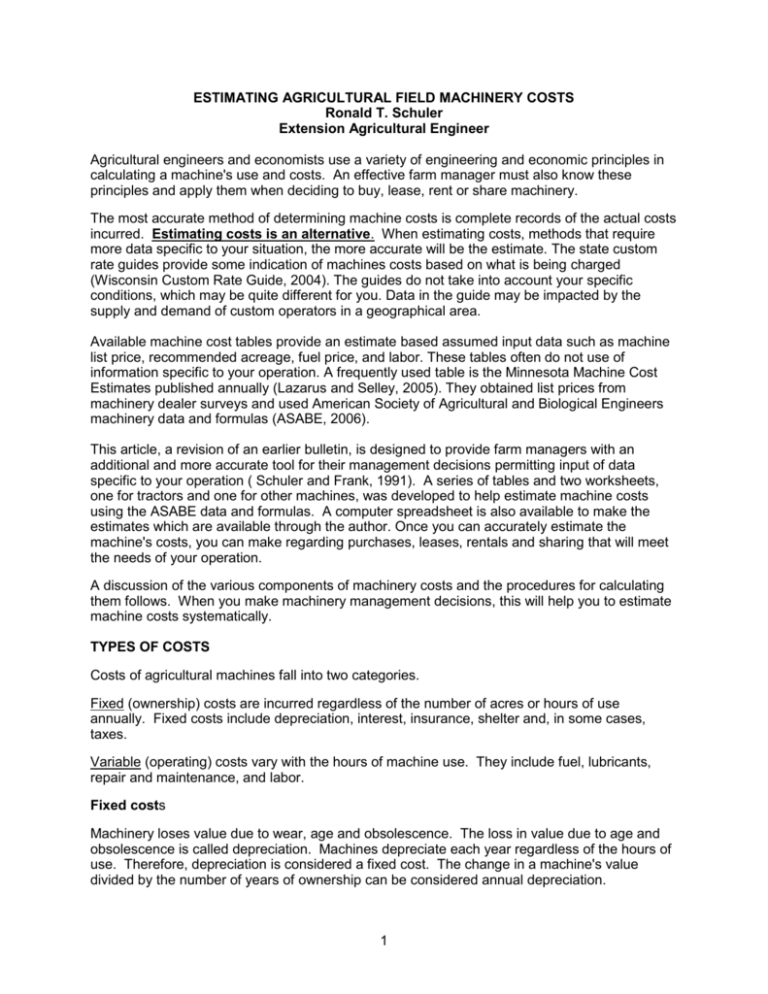
ESTIMATING AGRICULTURAL FIELD MACHINERY COSTS Ronald T. Schuler Extension Agricultural Engineer Agricultural engineers and economists use a variety of engineering and economic principles in calculating a machine's use and costs. An effective farm manager must also know these principles and apply them when deciding to buy, lease, rent or share machinery. The most accurate method of determining machine costs is complete records of the actual costs incurred. Estimating costs is an alternative. When estimating costs, methods that require more data specific to your situation, the more accurate will be the estimate. The state custom rate guides provide some indication of machines costs based on what is being charged (Wisconsin Custom Rate Guide, 2004). The guides do not take into account your specific conditions, which may be quite different for you. Data in the guide may be impacted by the supply and demand of custom operators in a geographical area. Available machine cost tables provide an estimate based assumed input data such as machine list price, recommended acreage, fuel price, and labor. These tables often do not use of information specific to your operation. A frequently used table is the Minnesota Machine Cost Estimates published annually (Lazarus and Selley, 2005). They obtained list prices from machinery dealer surveys and used American Society of Agricultural and Biological Engineers machinery data and formulas (ASABE, 2006). This article, a revision of an earlier bulletin, is designed to provide farm managers with an additional and more accurate tool for their management decisions permitting input of data specific to your operation ( Schuler and Frank, 1991). A series of tables and two worksheets, one for tractors and one for other machines, was developed to help estimate machine costs using the ASABE data and formulas. A computer spreadsheet is also available to make the estimates which are available through the author. Once you can accurately estimate the machine's costs, you can make regarding purchases, leases, rentals and sharing that will meet the needs of your operation. A discussion of the various components of machinery costs and the procedures for calculating them follows. When you make machinery management decisions, this will help you to estimate machine costs systematically. TYPES OF COSTS Costs of agricultural machines fall into two categories. Fixed (ownership) costs are incurred regardless of the number of acres or hours of use annually. Fixed costs include depreciation, interest, insurance, shelter and, in some cases, taxes. Variable (operating) costs vary with the hours of machine use. They include fuel, lubricants, repair and maintenance, and labor. Fixed costs Machinery loses value due to wear, age and obsolescence. The loss in value due to age and obsolescence is called depreciation. Machines depreciate each year regardless of the hours of use. Therefore, depreciation is considered a fixed cost. The change in a machine's value divided by the number of years of ownership can be considered annual depreciation. 1 NOTE: Depreciation for tax purposes must be determined differently and is not discussed here. You can use various methods to determine a machine's value at the end of a specific period of time. This article uses a schedule that considers the value of machinery on the open market. Interest on money spent on machinery is another fixed cost. This may be a cash cost when you borrow money or an opportunity cost when you buy machinery with money that you've saved. Since interest cost does not vary with machine use, it is a fixed cost. A rate of 8 percent of the remaining machine value is used here for estimating interest cost. Housing and insurance are also fixed costs. We use a rate of 2 percent of the machine's list price. Table 1 allows you to estimate fixed machine costs based on a machine's age and category. To determine the fixed costs, multiply the percentage for the appropriate machine age and category from Table 1 times the purchase price. For example, a new $30,000 tractor would have an estimated fixed cost of $13,671 (30,000 times 0.4557, from Table 1) for the first year. During the sixth year of ownership, the fixed cost is $2,367 ($30,000 times 0.0789, from Table 1). The assigned categories for additional machines are found in Table 2. Age (yrs) Table 1. Annual fixed costs in percent of list price by machine category and age. (Interest rate is 8 percent and housing, etc. is 2 percent.) 2006 ASAE Standards Equipment Categories 2 3 4 1 Combines Forage Harvester Other Field Tractors S.P. Windrowers Balers, Blowers Machine 1 45.57 51.19 57.92 54.61 2 11.01 11.85 10.37 11.15 3 10.13 10.49 9.18 9.86 4 9.32 9.28 8.12 8.71 5 8.57 8.22 7.19 7.70 6 7.89 7.27 6.36 6.81 7 7.26 6.43 5.63 6.02 8 6.68 5.69 4.98 5.32 9 6.14 5.04 4.41 4.70 10 5.65 4.46 3.90 4.16 11 5.20 3.95 3.45 3.68 12 4.78 3.49 3.06 3.25 13 4.40 3.09 2.71 2.87 14 4.05 2.74 2.39 2.54 15 3.72 2.42 2.12 2.24 To determine average fixed costs for a selected machine life, you must average these costs over the machine life. The average fixed costs per year for a machine with a 7-year life is the 2 sum of the first seven values in Table 1, divided by 7 and multiplied by the machine's value. An example: For a tractor, the sum of the first seven values is 99.75 percent. Dividing by 7, the average annual rate is 14.25 percent Table 2. Remaining value groups, wear-out life, and total repairs to wear-out life. (Source: 2006 ASAE Standards) Remaining Value & Estimated WearTotal Repairs in Wear-out Machinery Fixed Cost Group No. out Life (hrs) Life (% of list price) Tractor Two-wheel dr. 12,000 1 100 Four-wheel 1 16,000 dr. 80 Tillage Moldboard pl 4 2,000 100 Offset disk 4 2,000 60 Tandem disk 4 2,000 60 Chisel plow 4 2,000 75 Subsoiler 4 2,000 75 Field culti. 4 2,000 70 Spring tooth 4 2,000 70 Rolling packer 4 2,000 40 Rotary hoe 4 2,000 60 Rolling harrow 4 2,000 40 4 2,000 Row cultivar 80 Planting Planter 4 1,500 75 Grain drill 4 1,500 75 Harvesting Picker sheller 4 2,000 70 Combine Pull type 2 2,000 60 Self prop. 2 3,000 40 Mower cond. Sickle 4 2,500 80 Rotary 4 2,500 100 Rake 4 2,500 60 Baler Large rect. 3 3,000 75 Large round 3 1,500 90 Forage harv. Pull type 3 2,500 65 Self-prop 3 4,000 50 Potato 4 2,500 70 Other Fert. spreader 4 1,200 80 Boom sprayer 4 1,500 70 blower 3 1,500 45 wagon 4 3,000 80 3 Table 1 can also be used to estimate the fixed costs of used machinery. The average fixed costs for the period of ownership can be estimated by using the average percent for the period. For example, if you buy the $30,000 tractor used at 5 years of age and plan to own it for 7 years, then the average annual fixed cost is based on the average for years 6 through 12 from Table 1. In this case, the annual fixed percent is 6.23 percent, and the costs are $1,869 ($30,000 times 0.0623). Table 3 was developed from Table 1 to provide the cumulative average annual fixed costs, in percent. For the $30,000 tractor, the average fixed cost would be $4,275 per year ($30,000 times 0.1425 from Table 3) for the first 7 years of ownership. You would use this value in the machine's cost calculations. Since you will use most tractors for several different operations, you must know the fixed costs per hour in order to distribute these costs among all operations. To do this, divide the tractor's fixed costs by the estimated hours the tractor is used for all purposes during the year. Multiply the result by the number of hours the machine requires the tractor each year. Age (yrs) Table 3. Cumulative average annual fixed costs in percent of list price by machine category and age. Equipment Categories 2 3 4 1 Combines Forage Harvester Other Field Tractors S.P. Windrowers Balers, Blowers Machines 1 45.57 51.19 57.92 54.61 2 28.29 31.52 34.14 32.88 3 22.24 24.51 25.82 25.21 4 19.01 20.70 21.40 21.08 5 16.92 18.21 18.56 18.41 6 15.41 16.38 16.52 16.47 7 14.25 14.96 14.97 14.98 8 13.30 13.80 13.72 13.77 9 12.51 12.83 12.68 12.76 10 11.82 11.99 11.81 11.90 11 11.22 11.26 11.05 11.16 12 10.68 10.61 10.38 10.50 13 10.20 10.04 9.79 9.91 14 9.76 9.51 9.26 9.38 15 9.36 9.04 8.79 8.91 Variable costs Repair costs Repair costs depend on hours of annual use and are difficult to predict because operators differ greatly in the levels of repair and maintenance they do. Table 4 estimates repair costs based 4 on annual use and length of ownership. The values in the table are the percent of the machine’s list price to be used to determine the repair for the life of the machine. For example, consider a $7,500 moldboard plow that is used 100 hours per year. From Table 4, the average repair cost for a 7-year life and an annual use of 100 acres is 15.3 percent of the purchase price. For this plow, the life time repair costs are $1148 (0.153 times $7,500). The annual costs are $1148 divided by seven years, $164. Repair costs beyond the wear-out life are not included in Table 4. Wear-out life, based on the number of hours of operation listed in Table 2, estimates the useful life of a machine that has had average care and maintenance. Beyond this life, repair and maintenance costs become excessive. Table 4. Average accumulated costs as a percent of list price for the life of the machine. (Source: 2006 ASAE Standards) Machine Tractor, 2-wheel Drive Tractor, 4-wheel Drive Moldboard Plow Chisel Plow and Subsoiler Disk Field Cultivator and Spring-tooth Harrow Roller Packer and Harrow Annual Hours 200 400 600 800 200 400 600 800 50 100 150 200 50 100 150 200 50 100 150 200 50 100 150 200 50 100 150 200 7-year Life 1.4 5.4 12.3 22.0 0.6 2.4 5.3 9.4 4.4 15.3 31.7 53.1 6.4 17.0 30.0 44.8 3.0 9.8 19.6 31.9 6.3 16.4 28.9 43.2 4.1 10.1 17.0 24.8 5 10-year Life 2.8 11.1 25.2 44.4 1.2 4.8 10.8 19.2 8.3 29.0 60.2 101.0 10.6 28.0 49.4 73.9 5.5 18.0 35.9 58.5 10.2 27.0 47.6 71.3 6.5 16.0 27.1 39.4 15-year Life 6.3 25.2 56.7 100.8 2.7 10.8 24.3 43.2 17.3 60.2 * * 18.7 49.4 * * 11.0 35.9 * * 18.0 27.1 * * 11.0 27.1 * * Machine Row Cultivator Rotary Hoe Planting Equipment Corn Picker and Sheller Combine, Pulltype Combine, Selfpropelled Mower-cond. sickle Mower cond. rotary Pull-type Forage Harvester Forage Harvester, Selfpropelled Annual Hours 50 100 150 200 50 100 150 200 50 100 150 200 50 100 150 200 50 100 150 200 50 100 150 200 50 100 150 200 50 100 150 200 50 100 150 200 50 100 150 200 7-year Life 1.7 7.8 18.9 35.6 5.3 14.0 24.6 36.8 3.5 15.1 35.5 64.9 1.3 6.2 15.1 30.4 1.1 5.3 13.4 26.0 0.4 1.9 4.4 8.1 3.4 10.2 19.5 30.8 2.0 7.8 17.6 31.4 2.8 8.5 16.7 25.7 0.4 1.5 3.3 5.9 6 10-year Life 3.7 17.0 41.5 78.1 8.7 23.0 40.6 60.7 7.5 32.0 74.9 * 2.8 14.0 35.6 68.9 2.4 12.0 30.5 59.1 0.9 4.0 9.4 17.1 5.9 18.0 34.4 54.6 4.0 16.0 36.0 64.0 4.9 15.0 28.7 45.5 0.8 3.0 6.8 12.0 15-year Life 9.0 41.5 * * 15.5 40.6 * * 17.5 74.9 * * 7.2 36.6 * * 6.2 30.5 * * 2.2 9.4 22.0 40.2 11.4 34.4 65.9 * 9.0 36.0 81.0 * 9.5 28.7 54.9 * 1.7 6.8 15.2 27.0 Machine Baler, Large Square Annual Hours 50 100 150 200 Baler, Round 50 100 150 200 Potato Harvester 50 100 150 200 Fertilizer 50 Spreader 100 150 Boom Sprayer 50 100 150 Blower, Forage 50 100 150 200 Forage Wagon 50 100 150 200 * Exceeds estimated machine life. 7-year Life 1.5 5.3 10.9 18.3 6.5 22.6 46.9 78.8 4.4 11.5 20.3 30.4 16.1 39.6 67.1 10.5 25.8 43.6 3.3 11.6 24.0 40.3 3.0 9.0 17.3 27.4 10-year Life 2.9 10.0 20.7 34.8 12.3 43.0 89.2 * 7.2 19.0 33.5 50.1 25.6 63.0 * 16.7 41.0 69.5 6.3 22.0 45.6 * 5.3 16.0 30.6 48.5 15-year Life 6.0 20.7 43.0 72.2 25.6 89.2 * * 12.7 33.5 59.1 * 43.3 * * 28.2 69.5 * 13.1 45.6 * * 10.1 30.6 58.6 92.7 In order to determine repair costs, you must estimate annual hours of use. Divide the total acres for the operation by the effective field capacity of the machine in acres per hour. To estimate field capacity, multiply forward speed in miles per hour by the machine width in feet and by the field efficiency. Then divide by 8.25. Typical forward speeds and field efficiencies are listed in Table 5. For tractors, the repair cost per hour must be calculated for the entire year and then divided by the total annual use in hours. Then find the tractor repair costs charged to a given machine by multiplying the tractor repair costs per hour by the total time the tractor is used with that machine. Fuel costs Fuel costs depend on the hours of operation and the size of the tractor or power unit. To determine hourly fuel consumption, multiply the tractor power-take-off horsepower by a constant that provides a value in gallons per hour. That value is 0.06 for gasoline engines and 0.044 for diesel engines. 7 For example, a tractor or self-propelled machine with a 120 horsepower diesel engine will use an estimated 5.28 gallons of fuel per hour (120 times 0.044). By knowing the price of fuel and the number of annual hours of operation, you can estimate the annual fuel cost Table 5. List of field efficiency, suggested forward speed and timeliness constants. (Source: 2005 ASAE Standards) Suggested Timeliness Machine Field Efficiency Speed (mph) Factor Moldboard Plow 0.7-0.9 3-6 0.000-0.010* Chisel Plow 0.7-0.9 4-6.5 0.000-0.010 Disks 0.7-0.9 3.5-6.5 0.000-0.010 Field Cultivator 0.7-0.9 5-8 0.000-0.100 Roller Packer 0.7-0.9 4.5-7.5 0.000-0.010 Row Cultivator 0.7-0.9 3-7 0.011 Planter 0.5-0.75 4-7 0.005 Grain Drill 0.55-0.8 4-7 0.005 Picker Sheller 0.6-0.75 2-4 0.003 Combine 0.6-0.75 2-5 0.003 Mower-conditioner, Pull 0.75-0.85 3-6 0.010 Mower-conditioner, Rotary, Pull 0.75-0.90 5-12 0.010 Mower-conditioner, Self-propelled 0.7-0.85 3-8 0.010 Baler 0.6-0.9 2.5-8 0.028 Forage Harvester, Pull-type 0.6-0.85 1.5-5 0.028 Forage Harvester, Self-propelled 0.6-0.85 1.5-6 0.028 3-7 0.011 Boom Sprayer 0.5-0.8 * Tillage timeliness factor is dependent on its effect on planting. Lubricant costs To estimate lubricant costs, multiply the fuel costs by 0.15. Labor costs To estimate the annual labor cost to run a machine, multiply the hourly wage by the total hours required for the operation. The hourly labor cost may be the hourly wages of hired help or an estimate of the operator's time based on the skill required to operate the machine and perform other tasks, such as management. Timeliness costs Every field operation is best done at a certain time. If the operation is not done at that time, the quantity and/or quality of the crop will be reduced. For example, yield may decrease 1 percent per day if the operation is not done on the optimum date. This is called timeliness, which can be 8 calculated as a cost resulting from a decrease in income. The size of the cost depends on factors such as crop value, crop yield, machine operation, weather, and hours available for work per day. Timeliness costs become very important when you compare machines of different capacities, such as a twelve foot mower conditioner versus a sixteen foot mower conditioner. To estimate these costs, use Table 5 to determine a timeliness factor. Timeliness cost is calculated using factors and crop information. The formula is: timeliness cost ($ / hr ) where: Tc acres crop value yield Tx hours passes Tc = timeliness coefficient from Table 5. Tx = 4 if operations can be balanced evenly around the optimal time. Example: cutting or harvesting forages. = 2 if the operation should either start or end at the optimal time. Hours = the average hours per day this machine can normally be used. Crop Value = dollar value of crop in $/bu, $/T. Yield = crop yield in bu/A, T/A. Passes = the number of trips over the field or the number of cuttings. The following worksheets allow you to analyze machine costs using the principles and tables discussed earlier. Worksheet 1 is designed for tractors. This allows you to determine hourly fixed costs and repair costs, which you can then apportion to the various machines used with this tractor. Worksheet 2 is designed for machines other than tractors. To estimate costs for machines requiring a tractor, you must first calculate hourly fixed costs and repair costs for the tractor. If only tractor costs are evaluated, use Worksheet 2 but disregard items 3, 4d and 7. A completed example of worksheet 2 is also included. This entire process has been programmed onto spreadsheet software, which allows you to make numerous calculations evaluating a variety of options. The program allows you to select an interest rate that matches your situation. You will need Excel spreadsheet software to run the program. If you desire the spreadsheet contact Ron Schuler at rschuler@wisc.edu or for to UW-Extension, Cooperative Extension, Team Grain web site. The name of the file is MACHCOST06. References: ASABE. 2006. Agricultural Machinery Management. ASABE EP496.2, ASABE, St. Joseph, MI ASABE. 2006. Agricultural Machinery Management Data. ASABE D497.4, ASABE, St. Joseph, MI Lazarus, W. and R. Selley. Farm Machinery Cost Estimates for Late 2005. University of Minnesota Extension Service. 11 pp. Schuler, R.T. and G. G. Frank. 1991. Estimating Agricultural Machinery Costs. UW-Extension, A3510.12 pp. Wisconsin’s 2004 Custom Rate Guide. 2004. Wisconsin Agricultural Statistics Service. 11pp. 9 WORKSHEET 1 For tractors only. 1. 2. Information needed: a. Tractor model - _______________ b. List price - _______________ c. Tractor age - _______________ d. Tractor size, pto hp - _______________ e. Expected years of ownership - _______________ f. Estimate hours of annual use - _______________ Annual fixed cost: List price times fixed factor (Table 3) divided by 100 ____________ ____________ 100 3. $ ____________ Repair cost: Cost value from Table 4 times list price = repair cost for life of machine ____________ ____________ = $ ___________ Repair cost for life of the machine divided by expected years of life = annual repair cost ____________ / ____________ $ ____________ 4. Total fixed and repair annual costs (sum of 2 and 3) $ ____________ 5. Hourly tractor fixed and repair costs (divide 4 by 1f) (This cost is used when determining costs of other machines.) $ ____________ 10 WORKSHEET 2 For machines other than tractors. 1. 2. Information needed: a. Type of machine - ____________ b. List price - ____________ c. Machine age - ____________ d. Machine size - ____________ e. Tractor size, pto hp - ____________ f. Acres - ____________ g. Expected years of ownership - ____________ h. Tractor hourly fixed and repair costs (Worksheet 1) - ____________ Annual fixed cost: List price times fixed factor (Table 3) divided by 100 ________ ________ 100 3. $ _________ Estimated use (for tractors, estimate annual hours): a. Effective field capacity, acres per hour (Table 5). Forward speed times width times field efficiency divided by 8.25. ________ ________ ________ 8.25 = ________ ac/hr b. Estimated annual time, hours Acres times number of trips divided by effective field capacity. ________ ________ ________ = ________ hrs 4. Annual variable costs: a. Repair cost: Cost value from Table 4 times list price/100 = repair cost for life of machine ____________ ____________ / 100 = $ ___________ Repair cost for life of the machine divided by expected years of life = annual repair cost ____________ / ____________ = $ ___________ b. Fuel cost: Fuel factor times pto hp (1e; diesel = 0.044, gasoline = 0.06) $ ________ ________ ________ = ________ gal/hr Gal/hr times hours (3b) times fuel price: _____ _____ x $ ________ c. Lubricant cost: Fuel cost (4b) times 0.15: ________ 0.15 $ ________ d. Tractor cost : Hours (3b) times hourly tractor costs (1h) ________ ________ e. $ ________ Labor cost: Hourly wages times hours (3b) = ________ ________ $ ________ 5. Total out-of-pocket cost (sum of 2, 4a, 4b, 4c, 4d and 4e): $ ________ 6. 7. Hourly out-of-pocket costs: Total costs (5) divided by hours (3b) Timeliness cost: a. Information needed: Crop yield - ____________ Crop value - ____________ $ ________ Timeliness factor - ____________ b. Hours/day - ____________ Timeliness cost determination Crop value yield timeliness factor acre (hours/day 4) 8. ________ ________ ________ ________ (________ 4) $ ________ Hourly cost times hours (3b) = ________ ________ $ ________ Total costs (sum of 5 and 7b) $ ________ 11 WORKSHEET 2 (Sample) For machines other than tractors. 1. 2. Information needed: a. Type of machine – Rot. Mower-Cond b. List price - __23,5000____ __ c. Machine age - __0_________ d. Machine size - ___12 ft_____ e. Tractor size, pto hp - ___75_________ f. Acres - ___200_________ g. Expected years of ownership - ____10________ h. Tractor hourly fixed and repair costs (Worksheet 1) - ___16.32_____ Annual fixed cost: List price times fixed factor (Table 3) divided by 100 _23,500___ ___11.99___ 100 3. $ __2818___ Estimated use (for tractors, estimate annual hours): a. Effective field capacity, acres per hour (Table 5). Forward speed times width times field efficiency divided by 8.25. __6______ __12______ ___0.75_____ 8.25 = __6.55___ ac/hr b. Estimated annual time, hours Acres times number of trips divided by effective field capacity. __200______ ___3_____ __6.55______ = ___92_____ hrs 4. Annual variable costs: a. Repair cost: Cost value from Table 4 times list price/100 = repair cost for life of machine ___16_______ __23,500_____ / 100 = $ __3750_________ Repair cost for life of the machine divided by expected years of life = annual repair cost ___3750_____ / __10________ = $ __375____ b. Fuel cost: Fuel factor times pto hp (1e; diesel = 0.044, gasoline = 0.06) $ _375____ __0.044__ __75____ = ___3.30_____ gal/hr Gal/hr times hours (3b) times fuel price: _3.30_ _92__ x c. Lubricant cost: Fuel cost (4b) times 0.15: _759____ 0.15 d. Tractor cost : Hours (3b) times hourly tractor costs (1h) 2.50 _92_____ _16.32____ e. $ _759____ $ _114____ $ _1501___ Labor cost: Hourly wages times hours (3b) = __10.00__ __92____ $ _920____ 5. Total out-of-pocket cost (sum of 2, 4a, 4b, 4c, 4d and 4e): $ _3669___ 6. 7. Hourly out-of-pocket costs: Total costs (5) divided by hours (3b) Timeliness cost: a. Information needed: Crop yield - __2.0 t_________ Crop value - ___90/t_________ $ _39.90__ Timeliness factor - ___0.010_____ b. Hours/day - ___8_________ Timeliness cost determination Crop value yield timeliness factor acre (hours/day 4) 8. __2.0____ _90____ __0.010__ __200____ (__8_____ 4) $ _11.25__ Hourly cost times hours (3b) = _11.2 5_ __92___ _ $ _1035__ Total costs (sum of 5 and 7b) $ _4704__ 12
